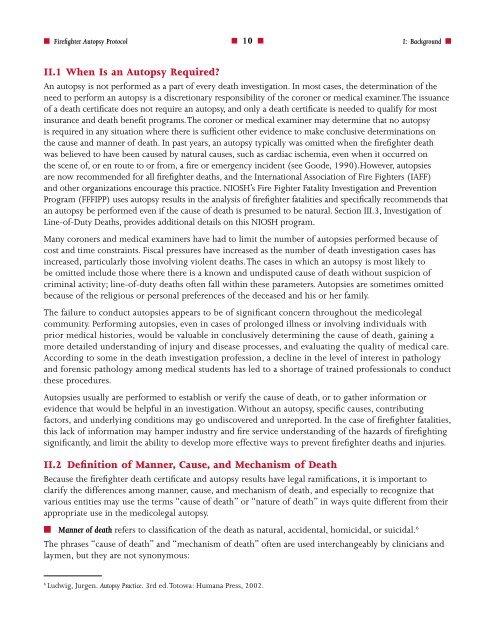Firefighter Autopsy Protocol - US Fire Administration - Federal ...
Firefighter Autopsy Protocol - US Fire Administration - Federal ...
Firefighter Autopsy Protocol - US Fire Administration - Federal ...
You also want an ePaper? Increase the reach of your titles
YUMPU automatically turns print PDFs into web optimized ePapers that Google loves.
■ <strong><strong>Fire</strong>fighter</strong> <strong>Autopsy</strong> <strong>Protocol</strong><br />
■ 10 ■<br />
I: Background ■<br />
II.1 When Is an <strong>Autopsy</strong> Required?<br />
An autopsy is not performed as a part of every death investigation. In most cases, the determination of the<br />
need to perform an autopsy is a discretionary responsibility of the coroner or medical examiner. The issuance<br />
of a death certificate does not require an autopsy, and only a death certificate is needed to qualify for most<br />
insurance and death benefit programs. The coroner or medical examiner may determine that no autopsy<br />
is required in any situation where there is sufficient other evidence to make conclusive determinations on<br />
the cause and manner of death. In past years, an autopsy typically was omitted when the firefighter death<br />
was believed to have been caused by natural causes, such as cardiac ischemia, even when it occurred on<br />
the scene of, or en route to or from, a fire or emergency incident (see Goode, 1990).However, autopsies<br />
are now recommended for all firefighter deaths, and the International Association of <strong>Fire</strong> Fighters (IAFF)<br />
and other organizations encourage this practice. NIOSH’s <strong>Fire</strong> Fighter Fatality Investigation and Prevention<br />
Program (FFFIPP) uses autopsy results in the analysis of firefighter fatalities and specifically recommends that<br />
an autopsy be performed even if the cause of death is presumed to be natural. Section III.3, Investigation of<br />
Line-of-Duty Deaths, provides additional details on this NIOSH program.<br />
Many coroners and medical examiners have had to limit the number of autopsies performed because of<br />
cost and time constraints. Fiscal pressures have increased as the number of death investigation cases has<br />
increased, particularly those involving violent deaths. The cases in which an autopsy is most likely to<br />
be omitted include those where there is a known and undisputed cause of death without suspicion of<br />
criminal activity; line-of-duty deaths often fall within these parameters. Autopsies are sometimes omitted<br />
because of the religious or personal preferences of the deceased and his or her family.<br />
The failure to conduct autopsies appears to be of significant concern throughout the medicolegal<br />
community. Performing autopsies, even in cases of prolonged illness or involving individuals with<br />
prior medical histories, would be valuable in conclusively determining the cause of death, gaining a<br />
more detailed understanding of injury and disease processes, and evaluating the quality of medical care.<br />
According to some in the death investigation profession, a decline in the level of interest in pathology<br />
and forensic pathology among medical students has led to a shortage of trained professionals to conduct<br />
these procedures.<br />
Autopsies usually are performed to establish or verify the cause of death, or to gather information or<br />
evidence that would be helpful in an investigation. Without an autopsy, specific causes, contributing<br />
factors, and underlying conditions may go undiscovered and unreported. In the case of firefighter fatalities,<br />
this lack of information may hamper industry and fire service understanding of the hazards of firefighting<br />
significantly, and limit the ability to develop more effective ways to prevent firefighter deaths and injuries.<br />
II.2 Definition of Manner, Cause, and Mechanism of Death<br />
Because the firefighter death certificate and autopsy results have legal ramifications, it is important to<br />
clarify the differences among manner, cause, and mechanism of death, and especially to recognize that<br />
various entities may use the terms “cause of death” or “nature of death” in ways quite different from their<br />
appropriate use in the medicolegal autopsy.<br />
■ Manner of death refers to classification of the death as natural, accidental, homicidal, or suicidal. 6<br />
The phrases “cause of death” and “mechanism of death” often are used interchangeably by clinicians and<br />
laymen, but they are not synonymous:<br />
6<br />
Ludwig, Jurgen. <strong>Autopsy</strong> Practice. 3rd ed. Totowa: Humana Press, 2002.
















